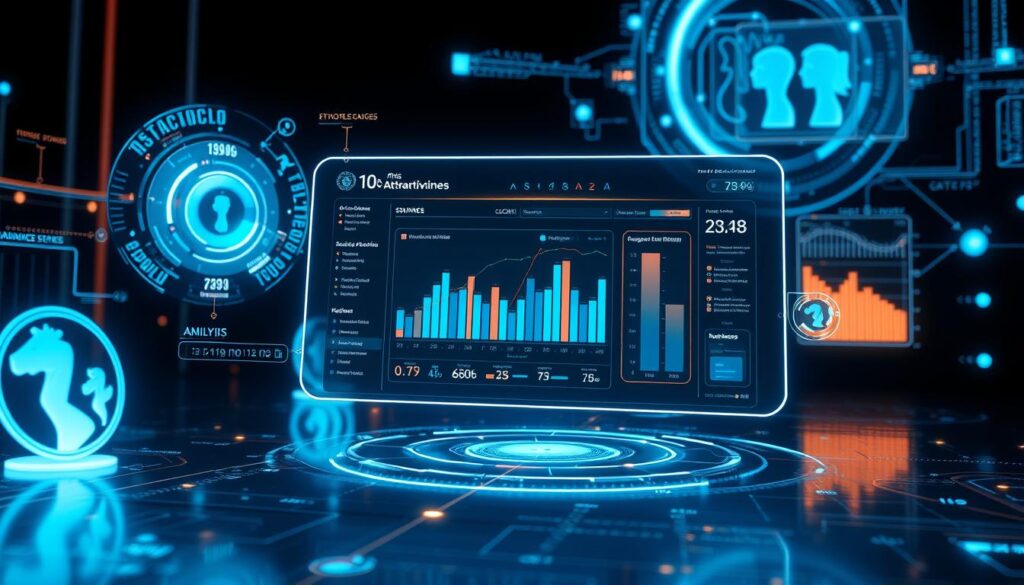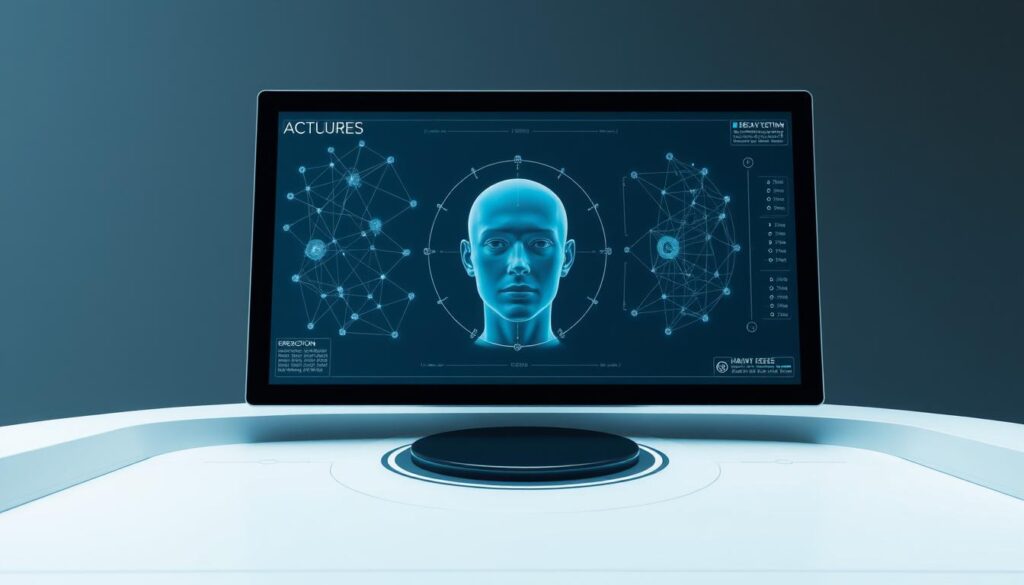2025 Engaging AI Attractiveness Test Insights You’ll Love
15 min read
Table of Contents
Can a machine really tell if we’re attractive? The rise of digital beauty evaluations has sparked both curiosity and debate. These tools are getting more popular, letting people see how their face looks and get a beauty score.

These artificial intelligence attractiveness evaluation tools are more than fun. They show us what beauty looks like today. By looking into how these tests work, we learn more about beauty’s role in our world and how we see it.
The Revolutionary 2025 AI Attractiveness Test Unveiled
The 2025 AI Attractiveness Test has changed how we see beauty. It uses machine learning facial attractiveness assessment and deep learning appearance analysis. These methods check how attractive someone is against global beauty standards.
Breakthrough Technology Behind the Test
The test’s tech is advanced, with smart algorithms and big facial datasets. Tools like AIFacefy learn from many beauty standards around the world. This lets them judge facial beauty in a detailed way. Key features include:
- Advanced neural networks for complex pattern recognition
- Comprehensive datasets covering various ethnicities and beauty standards
- Continuous learning capabilities to adapt to evolving beauty trends
This tech doesn’t just judge looks. It also looks at facial symmetry, skin quality, and more. These factors all play a part in what we find beautiful.
Development Team and Research Background
The team making the 2025 AI Attractiveness Test is full of experts. They know a lot about AI, beauty, and psychology. Their studies on beauty and AI help make the test strong and fair.
The team has worked with top beauty and fashion places. This means their AI model stays up-to-date with the latest beauty trends.
How the AI Attractiveness Test Works in Practice
The AI attractiveness test has changed how we see beauty. It relies on complex formulas to analyze facial features. This has led to an automated attractiveness ranking system that checks people against beauty standards.
Advanced Algorithms and Neural Networks
The heart of the AI test is its ai beauty scoring algorithm. It uses neural networks to look at facial data. These algorithms spot and judge facial features against beauty norms.
Neural networks are key. They help the system learn from big datasets and get better at judging beauty.
Data Collection and Processing Methods
To test beauty, the AI collects many facial images. It then uses advanced software to process them. This includes:
- Facial feature extraction
- Comparison with existing beauty standards
- Emotional response analysis
Facial Recognition Components
The facial recognition part is vital. It looks at symmetry, proportions, and skin quality.
Emotional Response Integration
Including emotional cues allows the system to assess more than just appearance. It sees how a person might be seen emotionally by others.
This mix of parts gives a full look at someone’s attractiveness. It uses both facts and feelings.
Key Features of the 2025 AI Attractiveness Assessment
The 2025 AI Attractiveness Assessment changes how we see beauty. It’s not just about looks; it looks at many factors that make someone attractive.
Multi-dimensional Beauty Analysis
This tool uses a multi-dimensional approach to beauty. It looks at skin quality, facial symmetry, and expressions. High-level facial recognition tech makes these evaluations accurate, offering a well-rounded view of beauty.
Cultural Context Integration
The 2025 AI Attractiveness Assessment understands different cultures. It’s trained on data from all over, showing various beauty standards.
Regional Beauty Standards Adaptation
The AI can adjust to regional beauty standards. It knows that what’s seen as attractive varies by culture. This makes the assessment more detailed and personal.
Historical Context Consideration
The AI also looks at historical context. Beauty trends evolve, and this AI keeps up. It offers insights that are both current and rooted in history.
This advanced tool gives a deep, culturally aware look at beauty. It uses AI to understand beauty in a new way.
Surprising Findings from the AI Attractiveness Test
The 2025 AI Attractiveness Test has brought new insights into beauty standards. It has changed how we see attractiveness. Researchers used an ai-based attractiveness assessment tool to study facial features in great detail.
Challenging Traditional Beauty Standards
The AI Attractiveness Test has shaken up old beauty standards. It shows that beauty isn’t just about looks. Instead, attractiveness is a mix of facial features like symmetry, proportions, and skin texture.
Some key findings are:
- The importance of facial symmetry in perceived attractiveness
- The role of skin health in determining attractiveness
- The impact of facial proportions on attractiveness perception
These discoveries tell us that old beauty standards are too simple. Attractiveness is complex and can’t be summed up by one trait.
Unexpected Correlations in Attractiveness Perception
The AI Attractiveness Test found surprising links in how we see beauty. For example, high cheekbones and a smooth forehead are seen as attractive in many cultures.
Some unexpected connections are:
- A strong link between facial averageness and attractiveness
- A connection between skin health and perceived attractiveness
- The role of facial expressions in attractiveness perception
These findings are important for understanding beauty and attractiveness. They show we need a more detailed way to judge beauty.
Scientific Validation and Accuracy Rates
Scientists have used many ways to check the AI attractiveness test. They looked at how accurate and reliable it is. This makes sure it’s good for studying facial beauty.
Peer-Review Process and Academic Reception
Experts in machine learning and psychology have reviewed the AI test. They liked its new way of looking at facial beauty. This review helped make the test better.
Comparison with Human Assessments
Researchers compared the AI test with what humans think is beautiful. They did this in a blind study. This means the humans didn’t know what the AI thought.
Blind Study Results
The AI test was very accurate in the blind study. It matched what humans thought was beautiful very well. It was good at spotting what makes a face attractive.
Statistical Significance of Findings
The study’s numbers showed the AI test was really accurate. It wasn’t just luck. Its machine learning facial attractiveness assessment skills are strong.
The AI attractiveness test is now seen as a trusted tool. It’s been tested a lot and shown to be accurate. It’s good for studying facial beauty.
Ethical Considerations and Controversies Surrounding AI Attractiveness Test
The rise of AI in judging human beauty has led to a big debate. Deep learning appearance analysis is getting better, but worries about privacy, bias, and discrimination are growing.
Privacy Concerns in Facial Analysis
Facial recognition in AI beauty tests is a big privacy issue. People’s face data is collected, stored, and analyzed without their full consent. This brings up concerns about how the collected data could be handled or misused.

Potential for Bias and Discrimination
Artificial intelligence attractiveness evaluation might also be biased. If the data used to train AI isn’t diverse, it could learn to discriminate. This could include race, gender, or age, making beauty standards unfair.
Regulatory Responses and Guidelines
Regulators are creating rules for using AI in beauty tests. These rules aim for transparency, fairness, and getting users’ consent. Companies are also urged to think about ethics when making these technologies.
As AI beauty tech improves, tackling these ethical issues is key. This way, we can ensure AI beauty assessments are fair, respectful, and protect individual privacy.
Real-World Applications of the AI Attractiveness Test
The AI Attractiveness Test is changing how we see beauty in many fields. It uses advanced tech for accurate beauty assessments. This opens new doors for businesses, researchers, and entertainment.
Commercial Uses in Beauty and Fashion Industries
The beauty and fashion world is using the AI Attractiveness Test to improve marketing and product making. Companies can analyze what people like with the automated attractiveness ranking system. This helps make personalized beauty products and advice.
Fashion brands use it to find out what beauty trends are popular. They then make their designs to match what people want. This keeps them ahead in a fast-changing market.
Medical and Psychological Research Applications
In medicine and psychology, the AI Attractiveness Test helps study beauty perception and its mental health effects. Researchers use the facial recognition attractiveness test to see how beauty affects social life and self-esteem.
This tech also helps in finding new treatments for body image issues. It gives insights into how we see beauty and its psychological impact.
Entertainment and Social Media Integration
The entertainment and social media world is also benefiting from the AI Attractiveness Test. Social media uses it to make beauty-related filters and challenges. This technology creates fun, interactive experiences that get users to share their results, boosting platform use.
As the AI Attractiveness Test grows, it will change how we see and interact with beauty in many areas of life.
Public Response and User Experiences
The 2025 AI Attractiveness Test has gotten a lot of attention. It uses attractiveness prediction using AI and has sparked a lot of talk on social media.
Viral Social Media Reactions
People are sharing their results and thoughts on the AI Attractiveness Test on social media. It’s interesting because it shows how AI can measure computer vision attractiveness measurement. This has led to some cool conversations about what makes someone attractive.
Personal Testimonials and Case Studies
Many have shared their stories about the AI Attractiveness Test. Some are surprised by how accurate it is. Others worry about using AI to judge beauty.
Celebrity Endorsements and Criticisms
Celebrities have also shared their thoughts on the AI Attractiveness Test. Some support it, while others are concerned about its effects on how we see ourselves.
Average User Feedback Analysis
Looking at what most users say, opinions are mixed. Some like how accurate and fun the test is. But others are worried about how it could be used.
Future Developments in AI Attractiveness Evaluation
The field of AI attractiveness evaluation is on the verge of a new era. Researchers are working hard to improve ai beauty scoring algorithms. We can look forward to better accuracy and a wider range of attractiveness assessments.
Upcoming Features and Enhancements
Soon, the ai-based attractiveness assessment tool will analyze facial features more deeply. It will consider skin health and facial symmetry. This will give us a fuller understanding of what makes someone attractive.
Potential Integration with Other Technologies
AI attractiveness evaluation is set to merge with other technologies. This will open up new possibilities. Two areas to watch are:
- Virtual Reality Applications
- Healthcare and Wellness Innovations
Virtual Reality Applications
AI and Virtual Reality (VR) could change the beauty and fashion worlds. For example, VR could let users try out different hairstyles or makeup without changing their look.

In healthcare, AI could help monitor skin health or spot early signs of diseases. This could lead to new ways to prevent and treat health issues.
These advancements show the bright future of AI in attractiveness evaluation. It promises exciting possibilities for both business and health.
Expert Opinions on the Impact of AI Beauty Assessment
The rise of AI in beauty assessments has sparked a lot of debate. Psychologists and tech leaders share their views on its effects. As machine learning facial attractiveness assessment and deep learning appearance analysis get better, it’s important to understand their impact.
Psychologists’ Perspectives on Beauty Perception
Psychologists are looking into how AI beauty assessments change traditional beauty standards and how we see ourselves. They point out a few key things:
- The chance for AI to make societal beauty norms stronger
- The effect of AI beauty assessments on self-esteem and body image
- The influence of culture on AI’s view of beauty
These experts say AI can look at physical traits but misses the deeper psychological aspects of beauty.
Tech Industry Leaders’ Forecasts
Tech leaders are hopeful about AI in beauty assessments. They see its use in:
- Personalized beauty advice
- Virtual try-on for makeup and cosmetic procedures
- Better customer experience in beauty and fashion
But they also stress the importance of thinking about ethics and AI biases.
Conclusion: The Future of Beauty in the Age of AI
The AI attractiveness test is a big step forward in understanding beauty. It has big implications for many industries and society.
As AI gets better at judging beauty, it will shake up old beauty standards. It will also give us new ways to see what’s attractive.
The beauty world will change a lot with AI. It will be used in beauty, fashion, and entertainment. It will also help in medical and psychological studies.
We need to think about the ethics of using AI to judge beauty. We must make sure the good parts of AI are used. And we should avoid its bad sides.
FAQ
What is an AI attractiveness test?
An AI attractiveness test uses artificial intelligence to judge how attractive a face is. It looks at different facial features and gives a score based on certain rules.
How does the AI attractiveness test work?
It uses advanced algorithms to study facial features like eyes, nose, and mouth. It also looks at the face’s overall shape. It considers cultural and regional beauty standards too.
What is the role of machine learning in AI attractiveness tests?
Machine learning is key in AI attractiveness tests. It lets the system learn from big datasets and get better over time. It finds patterns in facial beauty.
Are AI attractiveness tests biased?
Yes, AI attractiveness tests can be biased. This happens if the training data is not diverse or if the algorithms don’t consider cultural differences. But, developers are working to fix these issues.
Can AI attractiveness tests be used for commercial purposes?
Yes, they can. Companies in the beauty and fashion world use them for marketing and personalized advice.
How accurate are AI attractiveness tests?
Their accuracy depends on the system and the data it’s trained on. Some studies say they’re as good as human judgments. Others question their reliability.
What are the possible uses of AI attractiveness tests beyond beauty and fashion?
They could be used in medical research, entertainment, and social media. They help study beauty psychology, treat facial issues, or create realistic digital characters.
How do AI attractiveness tests integrate cultural context?
They use diverse datasets and consider regional beauty standards. This makes the assessments more nuanced and culturally aware.
What is the future of AI attractiveness evaluation?
The future will see more advanced algorithms and AI integration with technologies like augmented reality. They’ll also be used in healthcare and education.
How do experts view the impact of AI beauty assessments?
Experts have mixed opinions. Some see them as useful for understanding beauty. Others worry about their role in setting beauty standards and biases.
What is the role of deep learning in facial attractiveness assessment?
Deep learning is essential. It helps the system analyze complex facial patterns and learn from large datasets. This improves the accuracy and reliability of the assessments.
How do AI attractiveness tests handle privacy concerns?
They use anonymized data, encrypt images, and follow data protection laws. The specific steps vary by developer and application.
Reader Ratings & Reviews
There are no reviews yet. Be the first one to write one.
